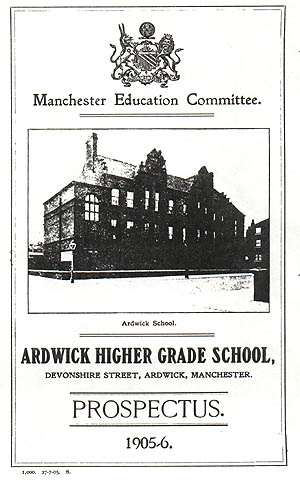|
1900 - 1920  At this point in its history,
the school was actually operating under two management systems. The
Higher Grade Senior Department, for students up to 13, was controlled
by the Manchester Board. Those 13 and over were the responsibility of
the Organised Science Department. The two sections received their
grants separately based on exam results and they were inspected
separately.
The Principal (not Headmaster)
at this time was Mr. Major, who was a firm disciplinarian. The staff
included certified teachers, certified assistants, and uncertified ex
Pupil Teacher Assistants. One of these was a Miss E. Shaw who came to
the school in 1897 from Ross Place School. She was employed at a salary
of £40 per annum. Another was Mr. F. Marquis, an outstanding
scholar at Ardwick School who had also attended Manchester Grammar
School.. Later he embarked on a brilliant career in business and
politics. As Lord Woolton he served in government alongside another
distinguished ex-scholar Ellen Wilkinson.
The Organised Science Section
was mandated to educate boys and girls beyond the statutory leaving age
and it depended on grants from the Science and Art Department. In 1894
that was the grand total of £33.10.0 but within 8 years that had
risen to £945.18.7. The grant was based on attendance, number of
pupils and the standard of work and performance. The grant for physics
was 19/6 per pupil which brought £134.11.0 for the 138 pupils.
Advanced physics was added at 35/- per pupil, Cookery and Needle work
at 7/- per pupil. The catchment area for the school in 1902 was likely
Ardwick, Longsight, Gorton and Openshaw.
In 1902 the Balfour Education Act was passed to address some of the anomalies that were developing in education, particularly with respect to "secondary" education. This resulted in the abolition of School Boards and the creation of Local Education Authorities. The former board schools were to remain strictly Elementary Schools, whilst new Secondary Schools were developed on the traditional Grammar School lines. The result in Ardwick was that in 1904 the Senior Departments of the Higher Grade and Organised Science School were reorganized as a Higher Elementary School. The school was no longer recognized as a Secondary School. It became the Ardwick Higher Elementary School filling a void between elementary and secondary school.  The building went through some physical changes. The Art room which used to occupy the whole of one side of the top floor in 1902 was divided to create a cookery section. In 1906 the advanced physics lab was altered to a "Practical Mechanics Laboratory". In 1910 the caretaker's house next to the school on Tiverton Street was converted into a Housewifery Centre. A laundry was built in the girls' playground, next door to the Housewifery Centre. It was a metal structure and became known as the "tin tabernacle". This configuration as the "Higher Elementary School" never really became popular with the Board of Education. In 1910 the Manchester Education Committee decided to reorganize these schools. One of the concerns was the fact that "Every year there are thousands of children in the Elementary schools who compete for admission to Secondary schools and fail to gain admission." In 1910 Manchester created six Central Schools. Ardwick Higher Elementary School was one of them and the Ardwick Central School was born. The 1916-17 prospectus for the school indicated that "These Central Schools are intended to give an improved general education to the children who are able to prolong their school lives, and also to those children, who, assisted by Scholarships, may enjoy the same advantage." Fees were 6d per week, for children of rate payers and 9d per week for children of non-rate payers, with remission in case of poverty. In 1916 the enrollment was 556, made up of 271 girls and 285 boys from 10 to 16 years. The allocation of free places was controlled by the Education Department at a rate of 25% of the number of children on the books. Free admission certificates for all the Central Schools were presented at a special ceremony. At the ceremony on November 28, 1914, Mr. Spurley Hey, the new Director of Education, presented the awards. The decisions about free admission were based on the results of free admission examinations. These were of course war years. In September 1914 the names of old boys who had joined up were displayed in the school. By 1915 that list included 200 names. Albert Cameron was awarded the D.M.C. in 1916. In 1917 Captain Robson D.M.C. was awarded the Military Cross and Croix de Guerre. In March 1917 a Roll of Honour was designed and placed in a prominent position in the Assembly Hall. Evening school was closed at 8:30 p.m. on the order of the police because of a Zeppelin raid. Mr. Major oversaw all of these changes. He led the school for 25 years. On September 4, 1917, he was suddenly taken ill and was found collapsed at his desk. He died on September 6, 1919 during an operation (probably to correct an existing heart problem). Three days later the school closed at 1:30 p.m. as a sign of respect and to allow the staff to attend the funeral.
|